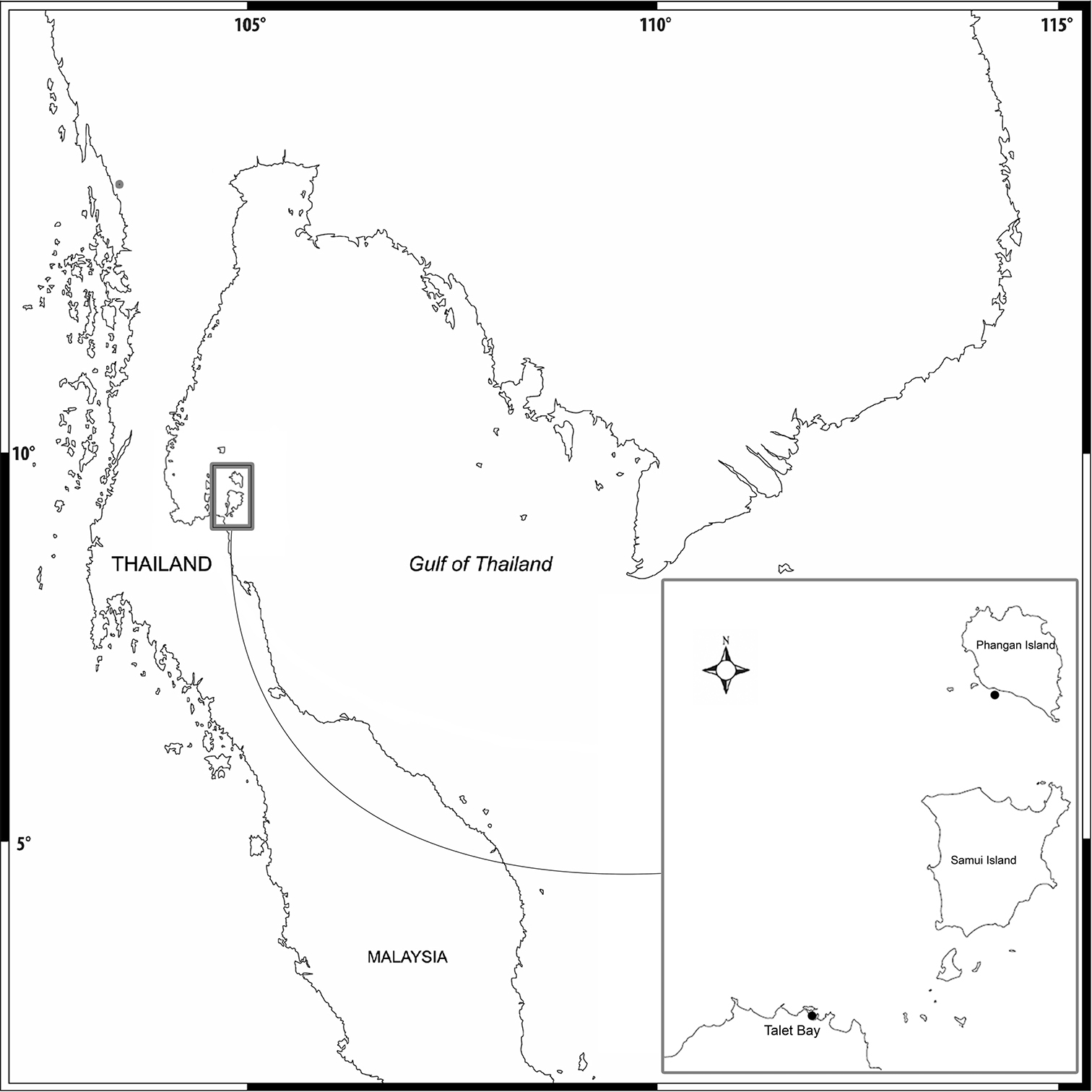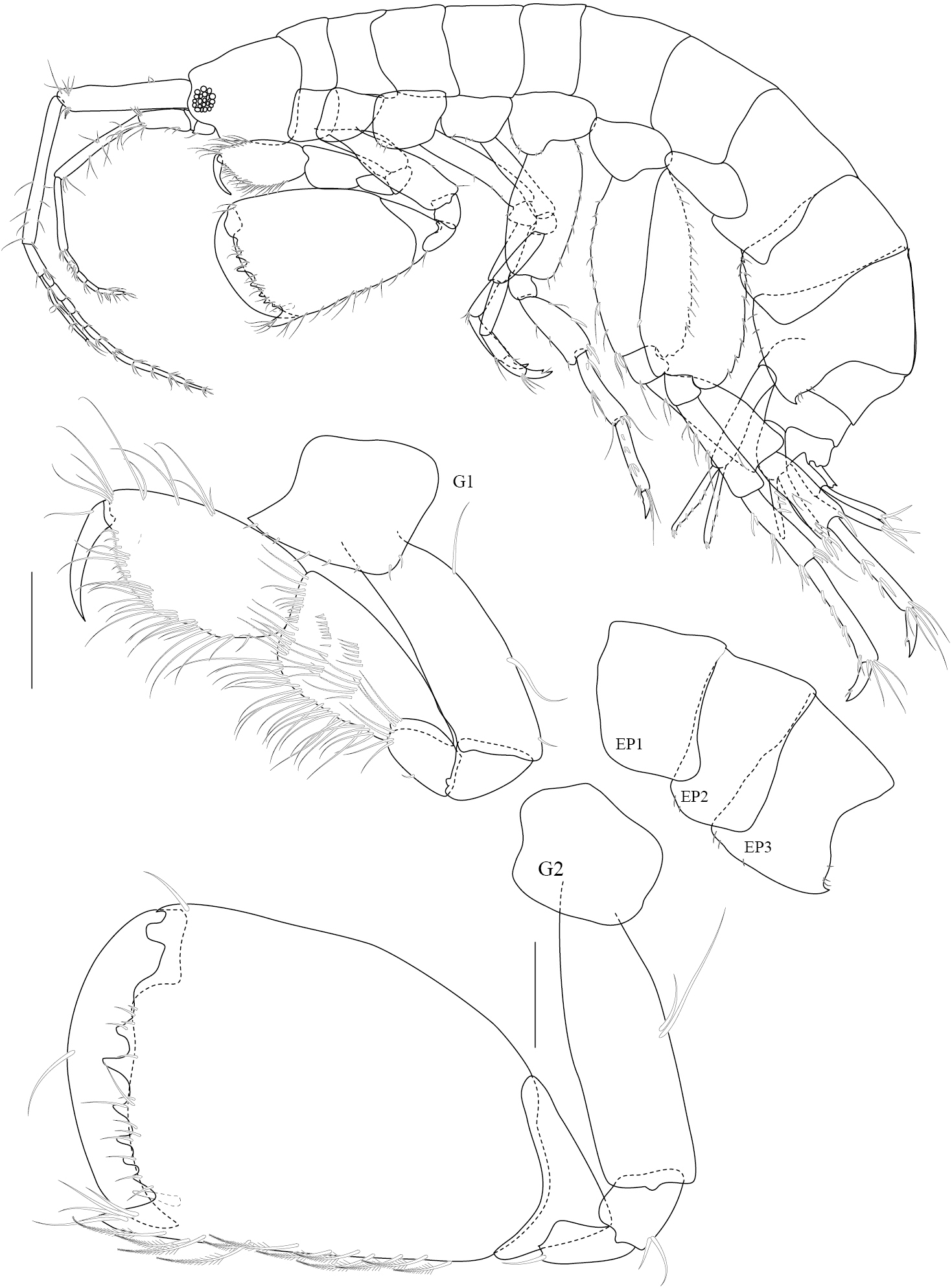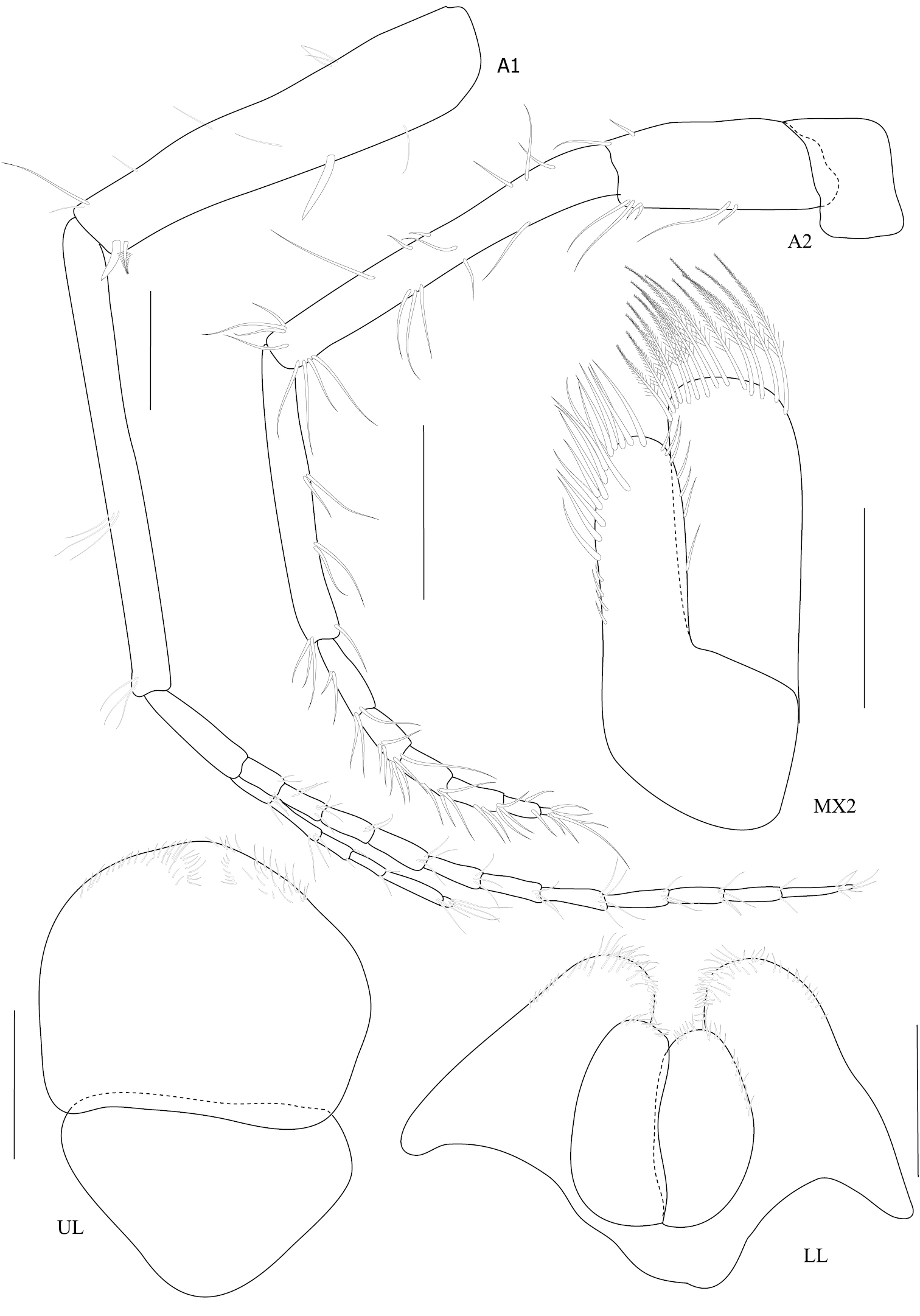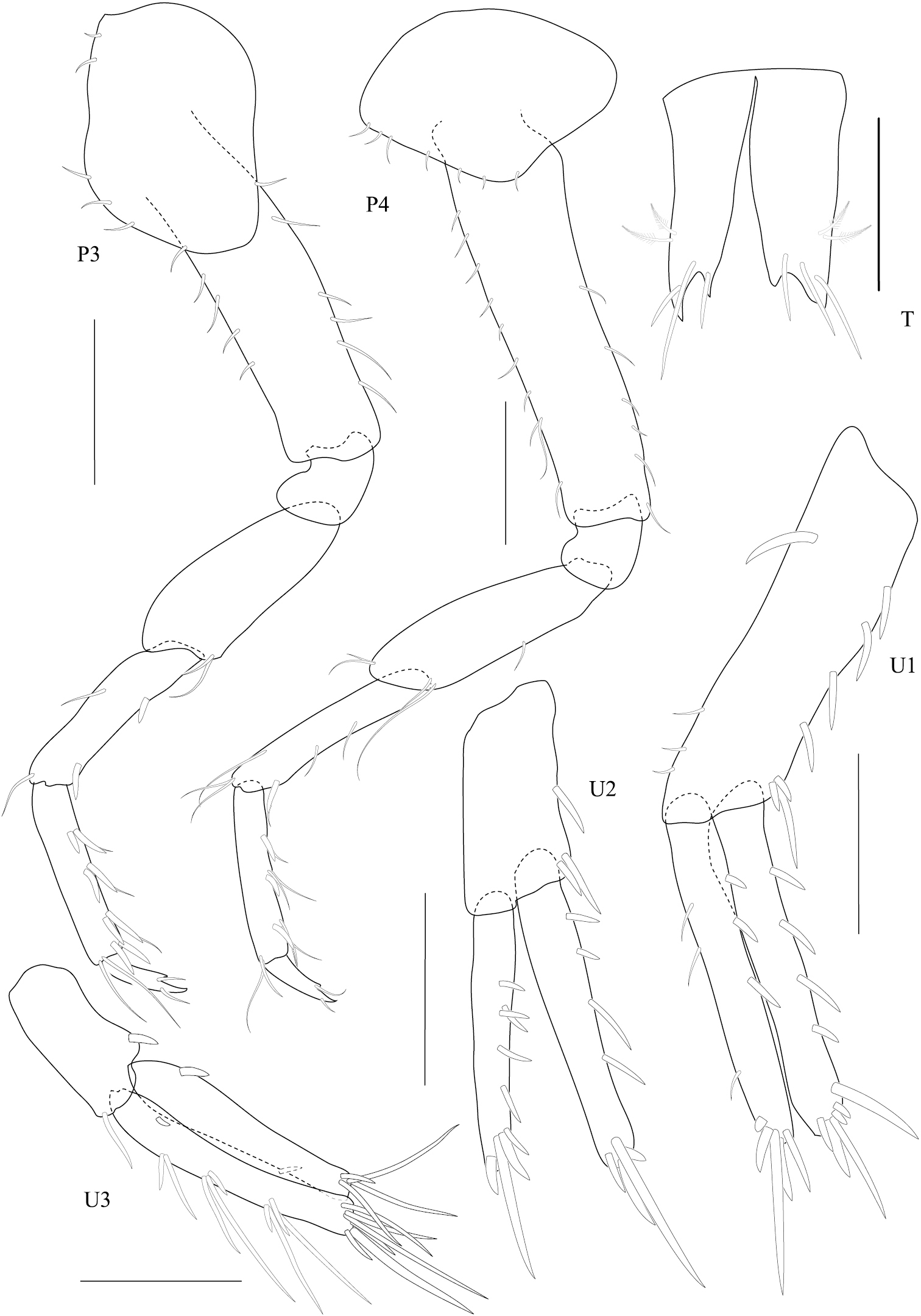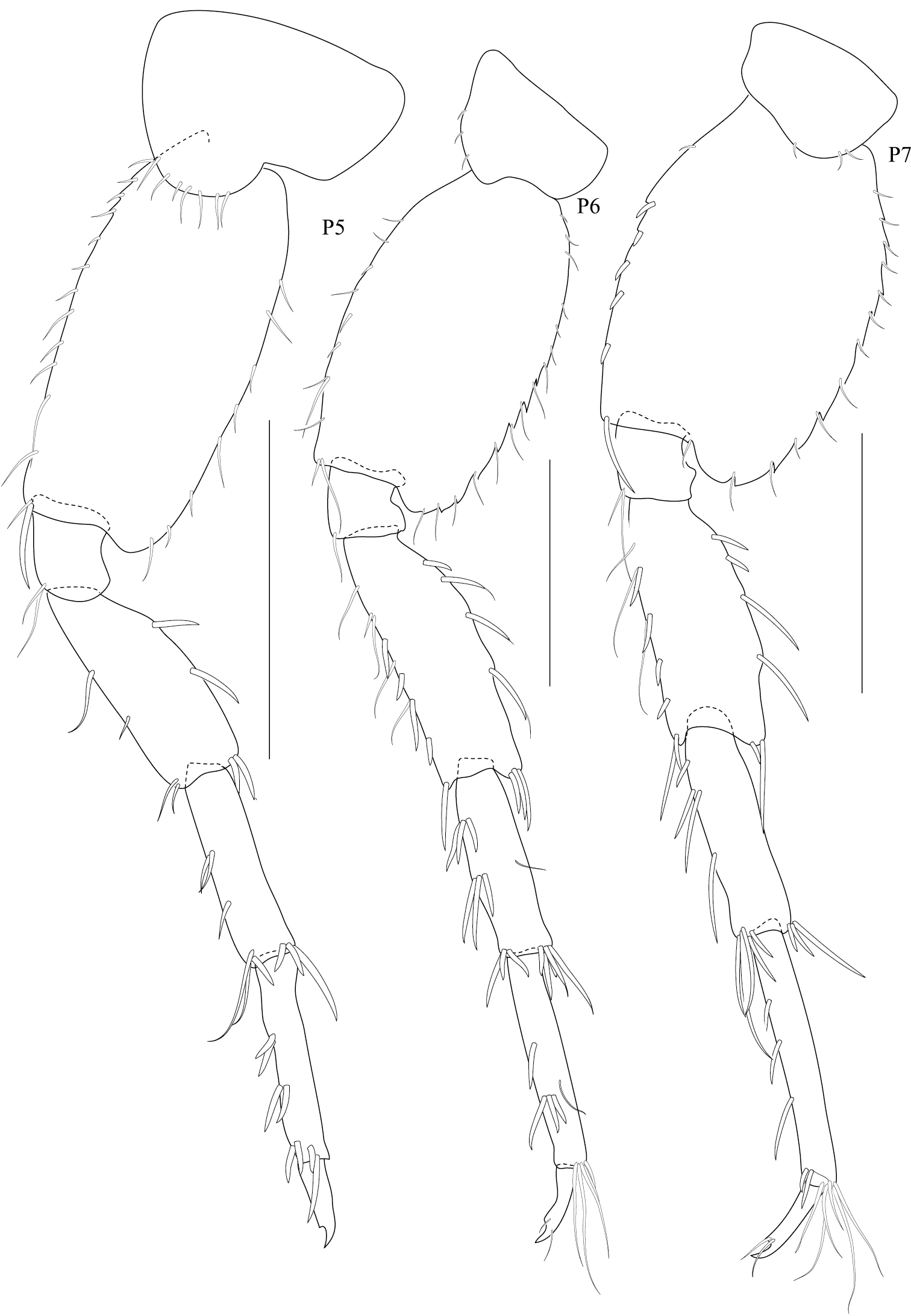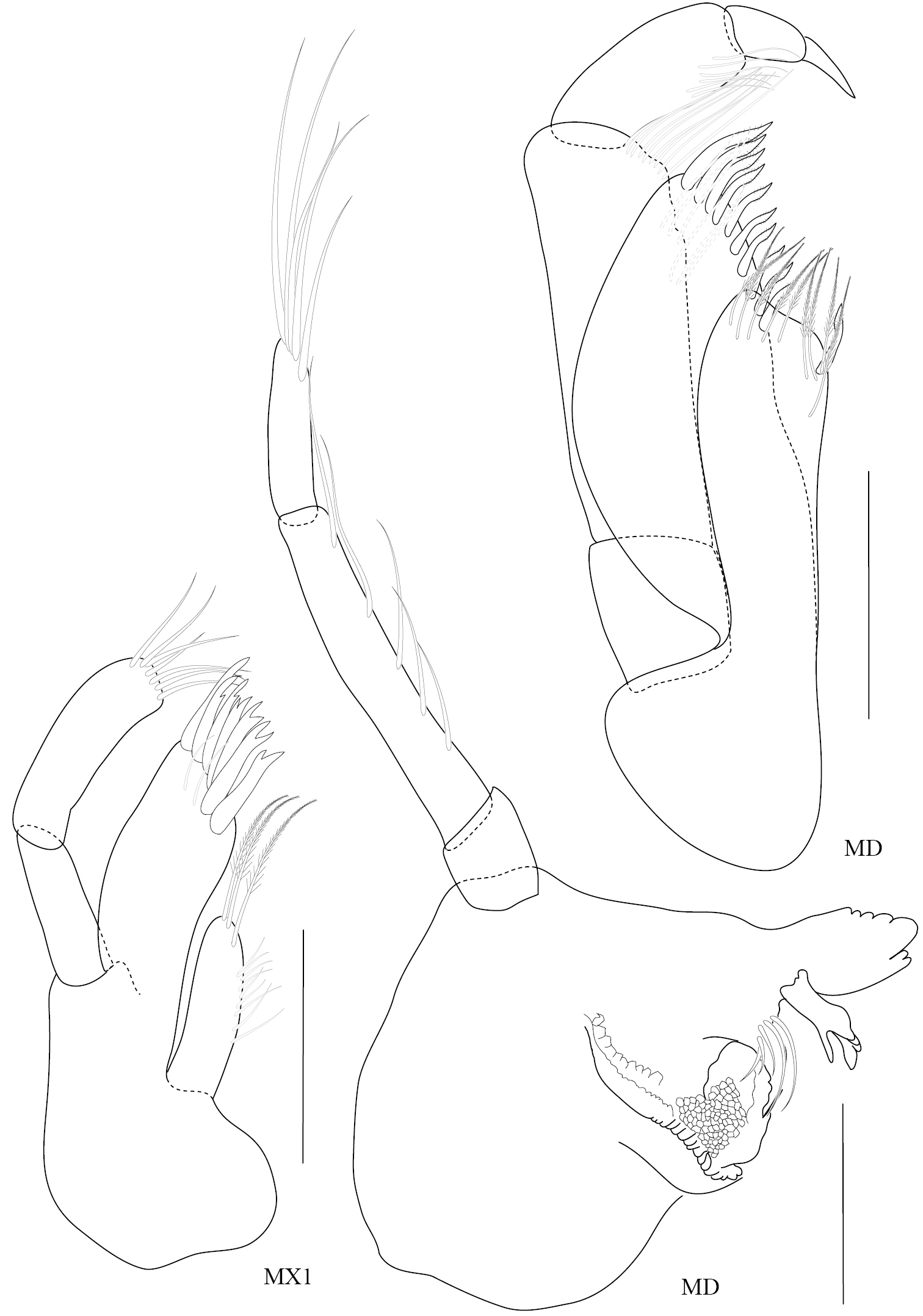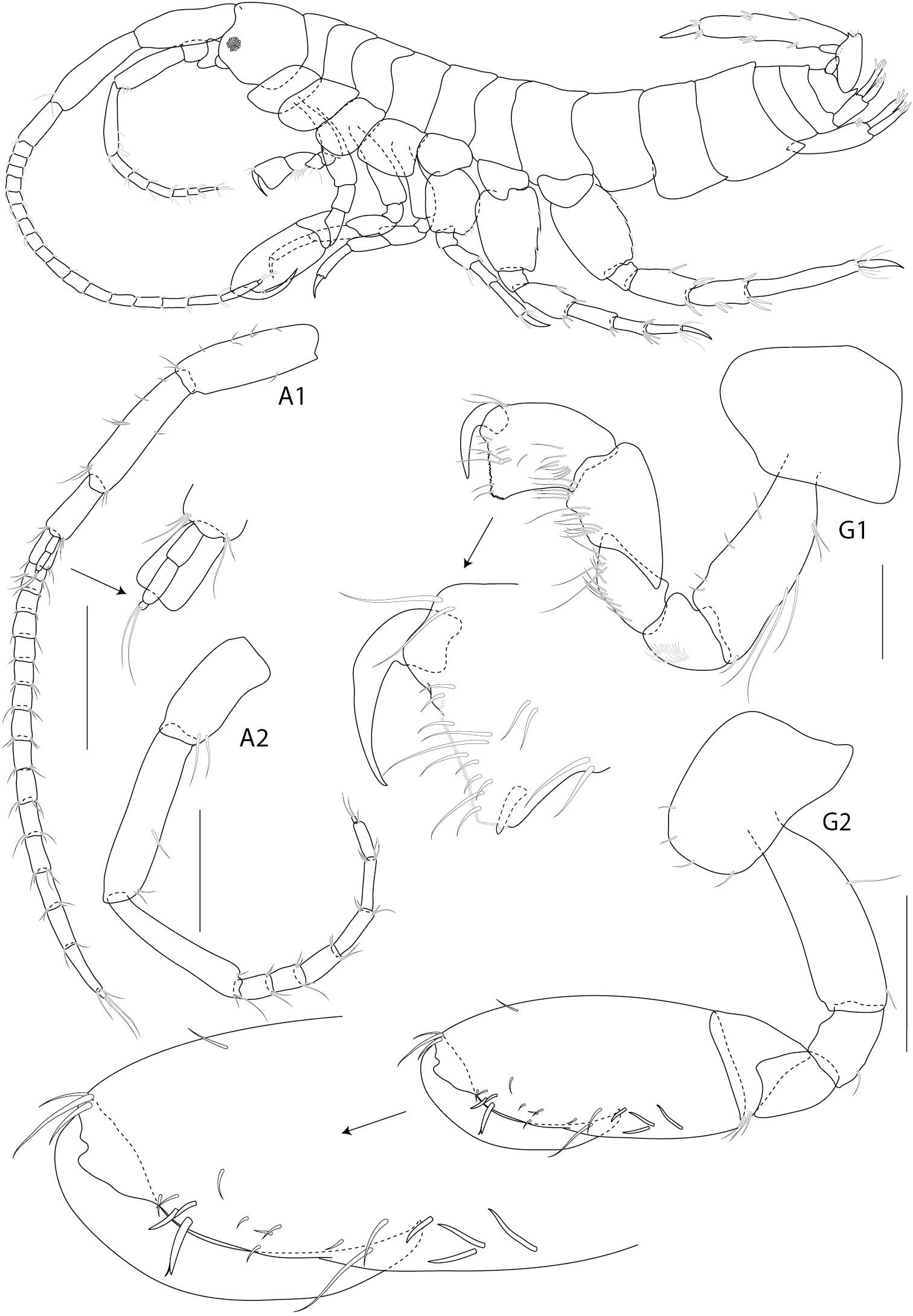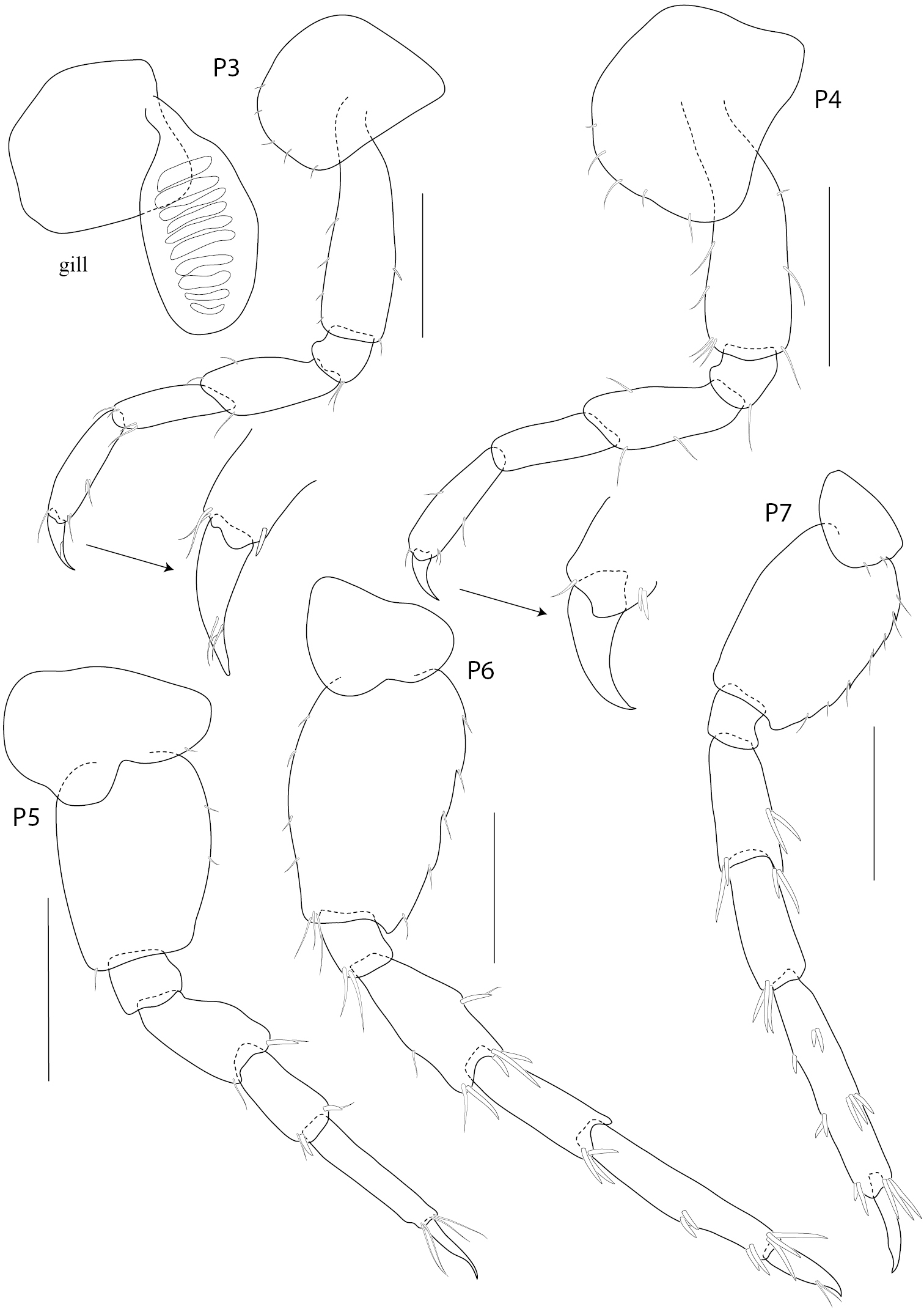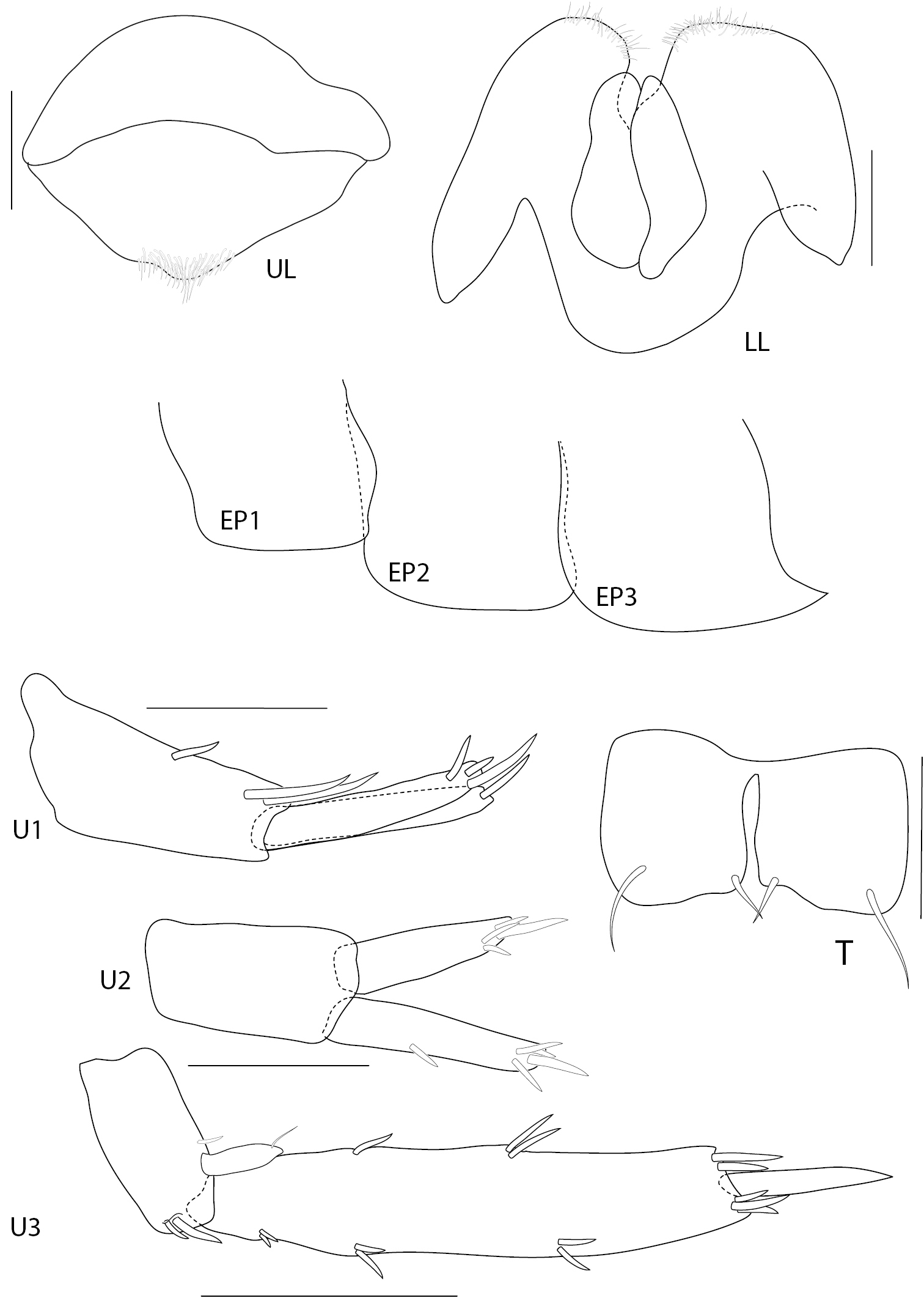






(C) 2013 Koraon Wongkamhaeng. This is an open access article distributed under the terms of the Creative Commons Attribution License 3.0 (CC-BY), which permits unrestricted use, distribution, and reproduction in any medium, provided the original author and source are credited.
For reference, use of the paginated PDF or printed version of this article is recommended.
Two new species of maerid and melitid Amphipoda, Maeropsis paphavasitae and Rotomelita longipropoda, respectively, collected from a seagrassbed of the Lower Gulf of Thailand, are described. Maeropsis paphavasitae is characterized by it seven teeth on the palm of gnathopod 2 and Rotomelita longipropoda can be recognized by its long gnathopod 1 propodus. Their characters are described and illustrated. All specimens are deposited at Princess Maha Chakri Sirindhorn Natural History Museum, Prince of Songkla University, Thailand and the Museum für Naturkunde, Berlin.
Crustacea, Amphipoda, Maeridae, Melitidae, Maeropsis paphavasitae, Rotomelita longipropoda, seagrass bed, Gulf of Thailand, new species, taxonomy
The Gulf of Thailand contains many seagrass beds on the coast both the mainland and the islands along the gulf. There are 12 species of seagrass reported from this area. The seagrass habitats in Thailand have been investigated since 1902, covering various topics from both fauna and flora (
Amphipods were collected using a 20×20cm2 Ekman’s grab in the mix of species seagrass beds of Talet Bay and Phangan Island (Figure 1). The sites were visited at low tide and the specimens were collected from the subtidal zone (2–5 m). The sediment was sieved with a 0.5 mm sieve. Amphipod specimens were sorted out and preserved in 70% ethanol. In the laboratory, the animals were examined using a compound microscope and later selected for dissection. The appendages were examined and figures were drawn using an Olympus CH30 light microscope with a camera lucida. The following abbreviations are used: A, antenna; G, gnathopod; HD, head; LL, lowerlip; MD, mandible; MX, maxilla; MP, maxilliped; P, pereopod; Pl, pleopod; T, telson; U, uropod; UR, urosome; UL, upperlip; r, right; l, left; ♂, male; ♀, female. The type material of the new species is deposited at Prince of Songkla University Zoological Collection (PSUZC) and the Museum für Naturkunde, Berlin (ZMB).
Map of sampling area.
(modified from
Maeropsis perrieri Chevreux, 1919 (type by monotypy).
Maeropsis brevispina (Kim & Kim, 1991); Maeropsis cobia Krapp-Schickel, 2009; Maeropsis griffini (Berents, 1983), Maeropsis perrieri Chevreux, 1919 (type species); Maeropsis paphavasitae sp. n. (this study); Maeropsis rathbunae (Pearse, 1908); Maeropsis revelata (Krapp et al., 1996); Maeropsis serratipalma (Nagata, 1965).
urn:lsid:zoobank.org:act:103B72E3-73B0-4DA4-A1CC-CC0BFD3D0C72
Holotype. ♂, THAILAND, Lower Gulf of Thailand, Talet Bay (09°18'39.5"N, 99°46'46.4"E), seagrass bed (associated with Thalassia hemprichii), 1 May 2008, Puttapreecha, R., PSUZC-CR-0198.
Paratypes, collected with holotype ZMB 27979 (3♀); PSUZC-CR-0199 (3♂; 5♀)
Based on male holotype. Body length 5.1 mm (from tip of rostrum to apex of telson). Body compressed, subcylindrical. Head, lateral cephalic lobe truncate, without rostrum, eyes round. Antenna 1, ratios of peduncular articles 1–3 9:10:2.5; peduncular article 1 with a ventromarginal robust seta and a distoventral robust seta; accessory flagellum with 6 articles.
Upper lip, (labrum) distally rounded. Lower lip, inner lobes small, pubescent; outer lobes covered with thin hair-like setae. Mandible, both incisors with 7 teeth; lacinia mobilis armed with 5 teeth on the left side and 4 teeth on the right side; molar short, cylindrical; palp 3-articulate with ratios of 4:9:3, article 2 with marginal setae and article 3 with apical setae. Maxilla 1, inner plate with 3 plumose setae apically and marginal fine setae medially; outer plate with 6 serrate robust setae apically; palp 2-articulate with apical fine setae. Maxilla 2, inner plate with lateral and medial marginal setae; outer plate broader than inner plate, distally setose. Maxilliped, inner plate with 9 plumose setae; outer plate semi-oval, inner margin with 9 robust setae distally; palp 4-articulate, article 3 with 15 fine setae, article 4 with 6 fine marginal setae.
Pereon. Gnathopod 1 subchelate, smaller than gnathopod 2; coxa anterodistally produced; basis posterior margin with 3 setae, longer than ischium and merus combined; carpus posterior margin and lateral surface densely setose; palm oblique. Gnathopod 2, basis with 2 posterior marginal setae; ischium and merus short; carpus triangular; propodus robust, subrectangular, 1.5 × longer than broad with posterior marginal plumose setae, palm transverse with 6 blunt teeth and an acute palmar corner, inner face bearing 1 subposterodistal robust seta; dactylus fits with palm, inner margin smooth, outer margin with 1 long seta. Pereopod 3–4 similar to each other, basis with anterior and posterior marginal setae. Pereopod 5 basis oval, posterior margin slightly produced distally, posterodistal lobe rounded. Pereopod 6– 7 similar, basis broader than pereopod 5, posterodistally produced with short anterior and posterior marginal setae; dactyli curved.
Pleon. Epimera 1–2 posteroventral corner smooth, not produced. Epimeron 3 produced posteroventrally, with 3 short ventral setae. Uropod 1 longest, peducle longer than rami, posterior margin fringed with robust setae, anterior with 1 basofacial robust seta. Uropod 2, peduncle shorter than both rami; inner ramus longer than outer ramus. Uropod 3, peduncle shorter than rami; inner ramus subequal to outer ramus, distally truncate; inner ramus bearing only 1 proximal robust seta and 4 terminal setae. Telson longer than wide, cleft more than 95% of its length, lobes distally incised, outer end of incision longer than inner one, with 3 long apical setae and 2 lateral plumose setae.
Female. (sexually dimorphic characters). No sexual difference.
Maeropsis paphavasitae sp. n. holotype, male, (PSUZC-CR-00198), 5.1 mm. Talet Bay, Lower Gulf of Thailand. All scales represent 0.2 mm.
Maeropsis paphavasitae sp. n. holotype, male, (PSUZC-CR-00198), 5.1 mm. Talet Bay, Lower Gulf of Thailand. Scales for A1 and A2 represent 0.2 mm; MX2, LL, UL represent 0.1 mm.
Maeropsis paphavasitae sp. n. holotype, male, (PSUZC-CR-00198), 5.1 mm. Talet Bay, Lower Gulf of Thailand. Scales for P3, P4, U1-3 represent 0.2 mm; T represents 0.1 mm.
Maeropsis paphavasita sp. n. holotype, male, (PSUZC-CR-00198), 5.1 mm. Talet Bay, Lower Gulf of Thailand. All scales represent 0.5 mm.
Maeropsis paphavasita sp. n. holotype, male, (PSUZC-CR-00198), 5.1 mm. Talet Bay, Lower Gulf of Thailand. All scales represent 0.1 mm.
The species is named in honor of Associate Professor Nittharatana Paphavasit of Chulalongkorn University, Thailand who contributed to the knowledge on seagrass habitats in Thailand.
Maeropsis paphavasitae sp. n. is very similar to Maeropsis serratipalma (Nagata, 1965) in the palm of gnathopod 2, which is transverse with 6 blunt teeth and a large defining tooth in both species. But the new species can be distinguished from Maeropsis serratipalma by the following characters: gnathopod 1 palm without clear defining palmar corner; gnathopod 2, merus not produced into a posterodistal tooth (vs. produced); propodus of gnathopod 2 subtriangular (vs. subrectangular), palm inner surface with 1 subposterodistal robust seta (vs. without); dactyli of pereopods 3-7 curved and smooth (vs. bearing two minute teeth); uropod 3 inner ramus with only 1 proximal seta (vs. armed with several marginal robust setae) and telson longer than broad (vs. broader than long).
(from
Rotomelita lokoa J.L. Barnard, 1977 (type by original designation).
Rotomelita ana J.L. Barnard, 1977; Rotomelita lokoa J.L. Barnard, 1977; Rotomelita longipropoda sp. n. (this study).
urn:lsid:zoobank.org:act:DAC77E5F-B08A-4640-96B9-A269E74ADABB
Holotype. ♂ (1.65 mm), THAILAND, Lower Gulf of Thailand, Phangan Island (9°41'48"N, 100°0'2"E), seagrass bed (associated with Thalassia hemprichii and Halophila ovalis), 1 July 2009, Bantiwiwatkul, N., PSUZC-CR-0195.
Allotype. ♀, collected with holotype, PSUZC-CR-0196 (gravid female, 1.66 mm) Other material. Same data as for holotype, PSUZC-CR-0197 (5♂; 5♀)
Based on male holotype. Total body length 1.65 mm (from tip of rostrum to apex of telson). Body, rather slender and subcylindrical. Head, slightly shorter than first 2 pereonites; rostrum not developed; inferior antennal sinus shorter than eyes, concave, about 0.2 times head length; eye distinct. Antenna 1, longer than antenna 2, ratios of peduncular articles 1–3 2:2:1; article 1 slender; flagellum with 16 articles plus 1 rudimentary article, 2 times as long as peduncle; accessory flagellum with 3 articles, last article scale-like. Antenna 2, peduncle slender; gland cone fleshy, short, not reaching to end of peduncular article 3; articles 2-5 ratios 1:1:3:3; inner margin of article 4 and 5 with sparse setae; article 5 slightly shorter than 4; flagellum short with sparse setae, longer than peduncular article 5, composed of 7 articles, last article scale-like.
Upper lip (labrum), round and broad. Lower lip, inner lobe small, outer lobe pubescent, mandibular process well developed. Mandible, left incisor with 6 teeth and right incisor with 5 teeth; lacinia mobilis armed with 4 teeth on both sides; molar triturative; palp 3-articulate with ratios 1:2:3, article 3 with 3 apical setae. Maxilla 1, inner plate triangular, small, with 3 apical robust setae, outer plate with 8 apical serrate robust setae; palp 2-articulate, article 1 shorter than 2, article 2 apical margin with 4 robust setae. Maxilla 2, inner plate with 5 slender apical setae; outer plate subequal to inner plate, with 8 slender setae. Maxilliped, inner plate narrow, short, reaching half of outer plate, apically provided with 6 plumose setae and 3 stout robust setae; outer plate broad, subrectangular, almost reaching palp article 3, with 5 apical and marginal setae and 2 apical robust setae; palp 4-articulate, with ratios 4.5:4:4:3, article 4 unguiform.
Pereon. Gnathopod 1, subchelate, smaller than gnathopod 2; coxal plate subrectangular; length ratios of articles from basis to dactylus about 10:4:4:7:6:4; basis slender, posterior margin bearing long setae; ischium short, subrectangular with short posteromarginal setae; merus subrectangular with long and short posteromarginal setae; carpus trapezoidal with long setae on posterior margin; propodus subtriangular, shorter than carpus, palm transverse, produced, with sparse setae, posterodistal corner minutely serrate, slightly bending inwards; dactylus shorter than palm, falcate. Gnathopod 2, subchelate; coxal plate short and wide, subrectangular, length ratios of articles from basis to dactylus about 14:5:5:6:16:12; basis slender, 3 times as long as wide, anterior margin straight; ischium subrectangular, subequal to merus; carpus triangular; propodus enlarged, oval, 2 times as long as wide, palm strongly oblique with sparse setae; dactylus falcate, slightly shorter than palmar margin, inner margin smooth, the inner surface not excavate.
Pereopod 3, slender and elongate; coxal plate small and subtrapezoidal, with 5 fine setae on anterioroventral margin; length ratios of articles from basis to dactylus 10:2:6:5:6:2; basis slender; ischium short, subrectangular; merus slightly longer than carpus, produced anteriorly; carpus slender with apical setae; propodus subrectangular; basis to propodus bearing sparse setae on both sides; dactylus falcate, shorter than propodus. Pereopod 4, similar to pereopod 3, coxal plate subrectangular with fine setae on anteroventral margin; length ratios of articles from basis to dactylus about 12:2:6:5:6:2; basis slender; ischium short, subrectangular; merus produced anterodistally; carpus slender, subequal to propodus; basis to propodus with sparse setae on both margins; propodus long and narrow; dactylus falcate and short. Pereopod 5, shortest; coxa bilobed; length ratios of articles from basis to dactylus about 8:2:5:4:6:3; basis subrectangular with short fine setae on posterior margin; ischium shortest; merus with a posterodistal robust seta and 1 anterodistal seta; carpus with distal robust setae on both sides; propodus with 4 distal long fine setae; dactylus short and curved. Pereopod 6 elongate, 1.6 times as long as pereopod 5; coxa posteriorly produced with rounded lobe; length ratios of articles from basis to dactylus about 12:3:8:7:11:4; basisposterior margin straight with minute castellations, with fine setae on both margins; ischium short with fine setae on anteroventral corner; merus oblong, with robust setae on posterior margins and posterodistal corner; carpus subrectangular with 3 anterodistal robust setae; propodus oblong, slender with marginal robust setae, setose posterodistally; dactylus falcate. Pereopod 7, subequal to pereopod 6; coxa short and wide, semicircular; length ratios of articles from basis to dactylus about 12:3:8:8:14:5; basis posteriodistally produced, bearing fine setae on posterior margin; ischium short and subquadrate; merus elongate with robust setae on both sides; carpus subequal to merus, bearing 3 anterodistal robust setae; propodus oblong, longer than merus, bearing robust setae on both margins and anterodistal corner; dactylus falcate.
Pleon. Epimera 1–3 each with small posterodistal tooth. Uropod 1, peduncle with 2 distal robust setae; rami slightly shorter than peduncle, armed with 3 apical robust setae. Uropod 2, peduncle subequal to rami; rami subequal, outer ramus with a marginal robust seta and apex armed with several long and short robust setae. Uropod 3, biramous; inner ramus minute, pointed apically, bearing 1 apicomedial robust seta; outer ramus biarticulate, with marginal robust setae, distal article short. Telson, broader than long, cleft, lobes very broad and apically truncate, each lobe with 2 apical setae.
Female. (allotype) (sexually dimorphic characters). Total body length 1.66 mm (from tip of rostrum to apex of telson).
Pereon. Gnathopod 1, subchelate, smaller than gnathopod 2; coxal plate subrectangular; length ratios from basis to dactylus about 10:4:4:6:5:4; propodus subtriangular, longer than dactylus, palm transverse with short marginal setae; dactylus falcate, tapering distally. Gnathopod 2, subchelate; length ratios from basis to dactylus about 10:5:5:6:8:5; basis slender, 2.5 times as long as wide, anterior margin weakly produced with sparse setae; ischium subrectangular; carpus triangular; propodus suboval, 1.6 times as long as wide, palm oblique, defined by 2 robust setae; dactylus falcate, slightly shorter than palmar margin, inner margin smooth.
Rotomelita longipropoda sp. n. holotype, male, (PSUZC-CR-00195), 1.65 mm, Phangan Island, Lower Gulf of Thailand. All scales represent 0.2 mm.
Rotomelita longipropoda sp. n. holotype, male, (PSUZC-CR-00195), 1.65 mm, Phangan Island, Lower Gulf of Thailand. All scales represent 0.2 mm.
Rotomelita longipropoda sp. n. holotype, male, (PSUZC-CR-00195), 1.65 mm, Phangan Island, Lower Gulf of Thailand. All scales represent 0.1 mm.
Rotomelita longipropoda sp. n. holotype, male, (PSUZC-CR-00195), 1.65 mm, Phangan Island, Lower Gulf of Thailand. All scales represent 0.05 mm.
Rotomelita longipropoda sp. n. allotype, female, (PSUZC-CR-00196), 1.66 mm, Phangan Island, Lower Gulf of Thailand. All scales represent 0.2 mm.
The specific name “longipropoda” is from latin ‘longi = long’ and ‘propoda = propodus’, referring to the relatively long propodus of male gnathopod 2 compared to congeners.
Rotomelita longipropoda new species shares some characteristics with Rotomelita lokoa Barnard, 1977 and Rotomelita ana Barnard, 1977 from Hawaii by having stalked coxal gills; weakly sexually dimorphic gnathopod 1 and 2; coxa 1 not expanded distally; coxa 4 proximally excavated, smooth pleon segments 1-3 and urosomite 1, and a deeply cleft telson, with truncate lobes.
However, the new species can be easily distinguished from its congeners by having eyes (vs. lacking eyes in Rotomelita lokoa and Rotomelita ana); antenna 1 peduncle without robust setae (vs. with 2 robust setae on ventroproximal margin in Rotomelita lokoa and Rotomelita ana); male gnathopod 2 with relatively long propodus (2.7 times as long as carpusvs, 1.6 times in the two other species) and the uropod 3 rami are shorter (2.2 times as long as peduncle) compared to the other two species (3.3 times as long as peduncle).
Rotomelita longipropoda is also similar to other Rotomelita subgroup i.e. Nainaloa Karaman & Barnard, 1979 and Tegano Barnard & Karaman, 1982. Rotomelita longipropoda can be distinguished from Nainaloa as follows: Rotomelita longipropoda gnathopod 1 palm has inner surface not excavate (inner face of propodus excavate in Nainaloa); pediculate gills (figure 8) (simple gill in Nainaloa); article 2 of pereopods 5—7 not lobed (lobed in Nainaloa) and truncate lateral cephalic lobes (prominent in Nainaloa). Besides, Rotomelita longipropoda is also allied to member of genus Tegano occurring in Indo-Pacific. They differ as follows: Rotomelita longipropoda has mandibular palp article 3 longer than article 2, bearing 3 apical setae (article 3 reduced with 1 apical seta in Tegano) and the telson short, cleft, lobes very broad and apically truncate (tapering and apically point in Tegano).
In terms of ecology Rotomelita, Nainalao and Tegano are recorded from fresh to brackish water (
The authors would like to thank Mrs Ratchanee Puttapreecha (Southern Marine and Coastal Resources Research Center) and Mrs Natthawadee Bantiwiwatkul (Marine and Coastal Resources Research Center, The Central Gulf of Thailand) for providing us withspecimens for this study. We are grateful to the Department of Biology, Faculty of Science, Prince of Songkla University and Museum für Naturkunde, Germany for the laboratory facilities. Part of this work was supported by the Higher Education Research Promotion and National Research University Project of Thailand. The senior author likes to thank the Graduate School of the Prince of Songkla University for a scholarship which made an oversea research stay in Germany possible. We also thank Dr. Azman Abdul Rahim for drawing the map of the sampling area.
